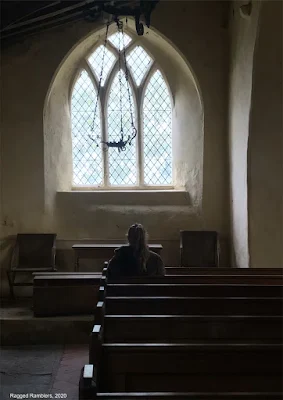Ancient Secrets at St Gregory, Heckingham
St Gregory, Heckingham, lies tucked
away down a narrow lane. Just as at its ‘sister’ church at nearby Hales, an
ancient track (now a public footpath) that is aligned with its south door, runs
into the distance in the fields opposite. Walk up the small hillock approaching
the graveyard entrance and you will see a plain wooden bench on which - with an
enigmatic reference to the surrounding landscape - the following words are
carved:
‘Ancient church.
Marshes know far older secrets’
To be honest, although ‘older secrets’ may well lie buried in
nearby marshes, I have no idea what they might be. What I do know, however, is
that this lovely church has some secrets of its own to reveal.
There is, for instance, the story of two daughters of John and
Elizabeth Crowe - both of whom were named Mary. At the west end of the north
aisle is a ledger slab on which is carved a grimly grinning skull. Here we
learn that Mary Crowe died in 1659. Meanwhile, the other Mary Crowe lies
interred under an almost identical stone at the east end of the aisle, she
having died in 1666. Clearly, the name Mary held a special place in the hearts
of her parents and was, as was quite common, re-used within families. Even
though several centuries lie between me and these deaths, my heart goes out to
these poor grieving parents.
Along the same aisle you will find an ostensibly nondescript
ledger slab set into the floor near the wall. I assume it marks the final
resting place of some anonymous person. But if you look closely and carefully
you will notice some crosses etched into the stone. The position and style of
these crosses strongly suggests to me that this a palimpsest: a re-cycled mensa
slab that, in the pre-Reformation church, would have been the altar within the
churches chancel.
At present a wooden funeral bier stands immediately next to the
late Norman font, a reminder of the cycle of life and death which this church
has been witness to. How excited John and Mary must have been as the priest
baptised their Mary’s in this very font. How many children, ‘time out of mind’
(as pre-modern documents sometimes say), must have had their heads wetted at
this font. Cold old stone and the flow of warm life and Love - these are some
of the layers of meaning that reside here.
 |
| An open door |
Within a church like Heckingham we can escape the tribulations of the wider world for a while. Whether you come to pray or to explore; to sit quietly, or to talk about some things that really matter with friends (or some combination thereof!) - whatever your reason, that open door really means something. It is part of a culture that says,
‘Here (at least), you are welcome’.
Within, we are able to heal.
 |
| Stillness within |
To support the work of the Churches Conservation Trust please click on the following link and make a financial contribution:
Churches Conservation Trust Donations
© Ragged Ramblers, 2020







Have you ever come across someone called Francis Kelly?
ReplyDeleteNo, I haven't Tom. Why so?
DeleteThe very first picture is so dark and full. There is the appearance of two separate sets of winds protruding from behind the front of the church. Birds or man made structures?
ReplyDeleteNaming two children identically, to replace the first, lost child, can confuse future generations. My grandfather had a brother of the same name, three years older.
"wings"
DeleteThank you for this beautiful piece. We walk there from our home in the old Hales Hospital, where we live. A truly special church.
ReplyDelete